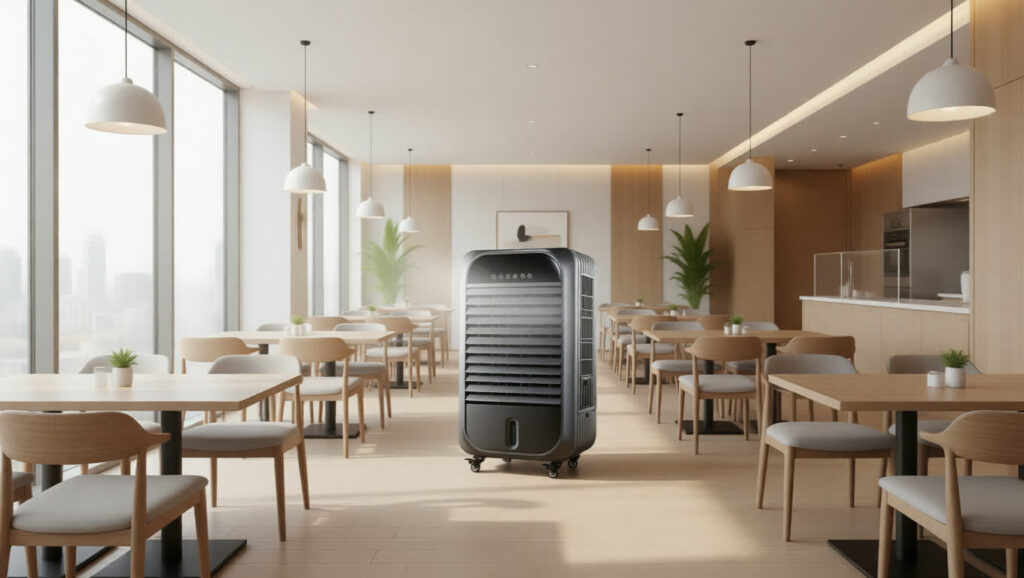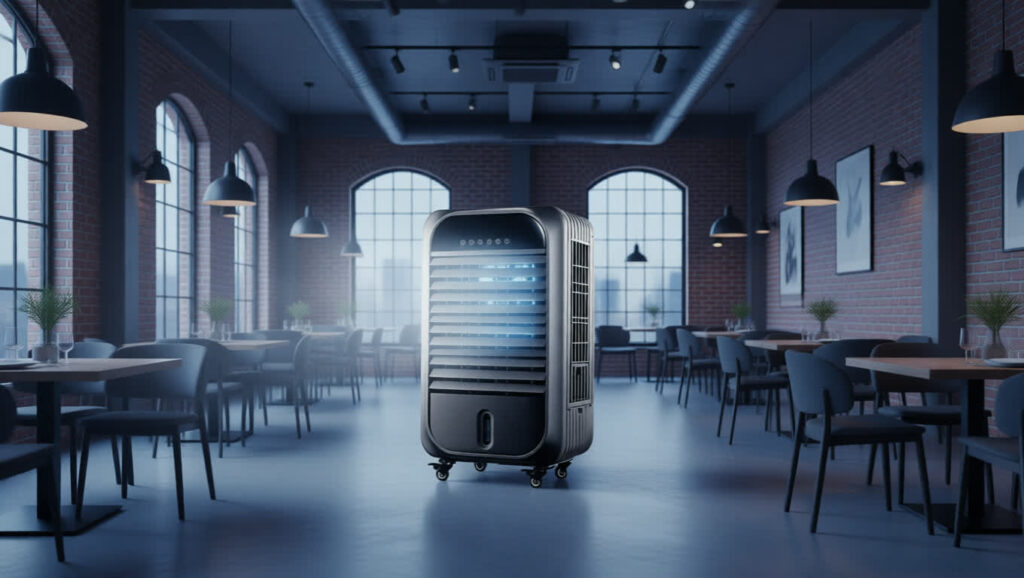Introduction: The Energy Challenge in Restaurants
Restaurants face a constant battle with high electricity bills, especially in hot climates where cooling systems run non-stop. With kitchens generating additional heat and customers expecting a comfortable dining experience, traditional air conditioning (AC) units often drive energy costs through the roof. Enter evaporative air coolers for restaurants—an energy-efficient, eco-friendly alternative that slashes bills while keeping spaces cool and inviting.
Unlike traditional AC systems that rely on energy-intensive compressors, evaporative coolers use the natural process of water evaporation to cool air, consuming up to 80% less energy. This article explores how evaporative air coolers can transform restaurant energy savings, improve customer satisfaction, and align with sustainable business practices—all while delivering a strong return on investment (ROI).

Why Restaurants Struggle with Cooling Costs
Restaurants are energy-intensive businesses, with cooling systems accounting for 28–35% of total energy consumption, according to the U.S. Department of Energy. Several factors contribute to these high costs:
- Long Operating Hours: Restaurants often run HVAC systems for 12–16 hours daily to maintain comfortable indoor and outdoor dining areas.
- Rising Electricity Prices: Utility rates have increased steadily, with commercial rates averaging $0.12–$0.20 per kWh in the U.S.
- Kitchen Heat Load: Cooking equipment like ovens, grills, and fryers generates significant heat, forcing cooling systems to work harder.
For restaurant owners, these challenges translate to monthly energy bills that can eat into already tight profit margins. Traditional AC systems, while effective, are not always the most cost-efficient solution, especially for open-air patios or large dining spaces. This is where energy-efficient cooling for restaurants offers a smarter alternative.
How Evaporative Coolers Work and Save Energy
Evaporative Cooling Science
Evaporative air coolers operate on a simple principle: water absorbs heat as it evaporates, cooling the surrounding air. These systems draw warm air through water-soaked pads, where evaporation lowers the air temperature. A fan then circulates the cooled air into the restaurant. Unlike traditional AC, which relies on refrigerants and compressors, evaporative coolers use only a fan and a water pump, drastically reducing energy consumption.
Energy Use Comparison vs. AC
The energy savings are significant. Traditional AC units can consume 3–5 kW per hour for a medium-sized restaurant, while evaporative air coolers typically use just 0.5–1 kW. This translates to 70–80% lower energy costs, depending on the system size and climate. For example:
- A 5-ton AC unit running 12 hours daily at $0.15/kWh costs approximately $2,700 annually.
- An equivalent evaporative cooler might cost just $500–$800 per year to operate.
Additionally, evaporative coolers are eco cooling systems that avoid harmful refrigerants like Freon, reducing a restaurant’s carbon footprint and aligning with sustainability goals.
Real-World Energy Savings for Restaurants
Restaurants adopting evaporative air coolers report impressive results. Consider the case of a medium-sized bistro in Arizona, a hot and dry climate ideal for evaporative cooling. By switching to an evaporative cooler for its outdoor patio, the restaurant reduced its cooling energy costs by 30% monthly, saving $1,200 annually. The system also improved air circulation, eliminating hot spots and creating a more comfortable dining experience.
Another example is a fast-casual chain in Nevada that installed evaporative coolers across its outdoor seating areas. Compared to extending their AC system outdoors, the chain saved one-third of the cost while maintaining a cool, inviting atmosphere that boosted customer dwell time and sales.
These case studies highlight why restaurant energy savings with evaporative coolers are not just theoretical but achievable in real-world settings.

ROI and Payback Period Explained
Investing in evaporative air coolers for restaurants is not only about energy savings but also about financial returns. Here’s a breakdown:
- Initial Costs: Evaporative coolers are generally 20–40% cheaper to purchase and install than traditional HVAC systems. For a 2,000-square-foot restaurant, a high-quality cooler might cost $2,000–$4,000, compared to $6,000–$10,000 for an AC unit.
- Operating Costs: As mentioned, coolers use significantly less electricity, saving $100–$300 monthly in hot climates.
- Payback Period: Depending on usage and local energy rates, the payback period is typically 1–2 years. For example, a $3,000 cooler saving $1,500 annually breaks even in about 24 months.
Beyond direct savings, evaporative cooler ROI includes indirect benefits:
- Customer Retention: Comfortable dining spaces encourage repeat visits and longer stays, boosting revenue.
- Sustainable Branding: Eco-friendly cooling appeals to environmentally conscious customers and supports green certifications like LEED.
More Than Just Savings: Added Benefits for Restaurants
Evaporative air coolers offer benefits beyond restaurant energy savings:
- Improved Air Circulation: These systems deliver a steady flow of fresh, cooled air, reducing stuffiness and eliminating hot spots in dining areas.
- Ideal for Outdoor Dining: Patios and open-air spaces, where traditional AC is impractical, stay cool and inviting, extending usable seating areas.
- Low Maintenance: Unlike complex HVAC systems, evaporative coolers require minimal upkeep—mainly cleaning water tanks and replacing pads annually.
- Sustainability: By using less energy and no refrigerants, coolers support sustainable cooling solutions, helping restaurants meet environmental goals.
Key Considerations Before Installing Evaporative Coolers
While evaporative coolers are highly effective, they’re not a one-size-fits-all solution. Here are key considerations:
- Climate Suitability: Evaporative coolers work best in dry, hot climates (e.g., Arizona, Nevada) where humidity is below 50%. In humid regions, their cooling efficiency drops, though hybrid systems (pairing with AC) can help.
- Maintenance Needs: Regular cleaning of water tanks and pads prevents mold and ensures performance. Plan for quarterly maintenance checks.
- Proper Sizing: Choose a cooler with adequate cubic feet per minute (CFM) for your space. For example, a 2,000-square-foot restaurant needs approximately 4,000–6,000 CFM.
- Expert Consultation: Work with an HVAC engineer or energy auditor to assess your restaurant’s needs and optimize system placement.
Pro Tip: For restaurants in humid climates, consider a hybrid setup where evaporative coolers handle outdoor areas and AC covers indoor spaces. This maximizes energy-efficient cooling for restaurants while maintaining comfort.
Conclusion: Smarter Cooling, Lower Bills
For restaurant owners grappling with high energy costs, evaporative air coolers for restaurants offer a game-changing solution. By leveraging the natural power of water evaporation, these eco cooling systems cut energy use by up to 80%, deliver a fast ROI, and enhance customer comfort. From reducing hot spots to enabling sustainable branding, the benefits extend far beyond the balance sheet.
Considering upgrading your restaurant’s cooling system? Explore low-cost cooling restaurant solutions with evaporative air coolers and start saving on bills today. Consult with experts like KoolAir, leaders in industrial cooling, to find the perfect system for your space.
